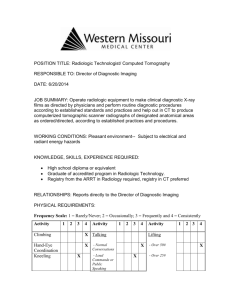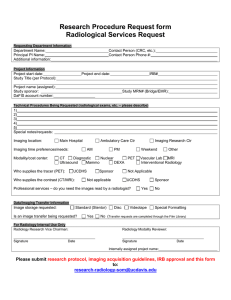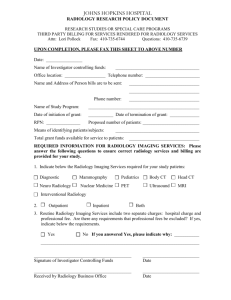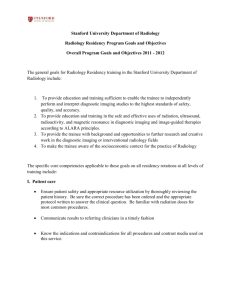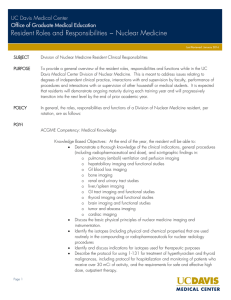Resident Roles and Responsibilities ~ Nuclear Medicine / Diagnostic Radiology
advertisement
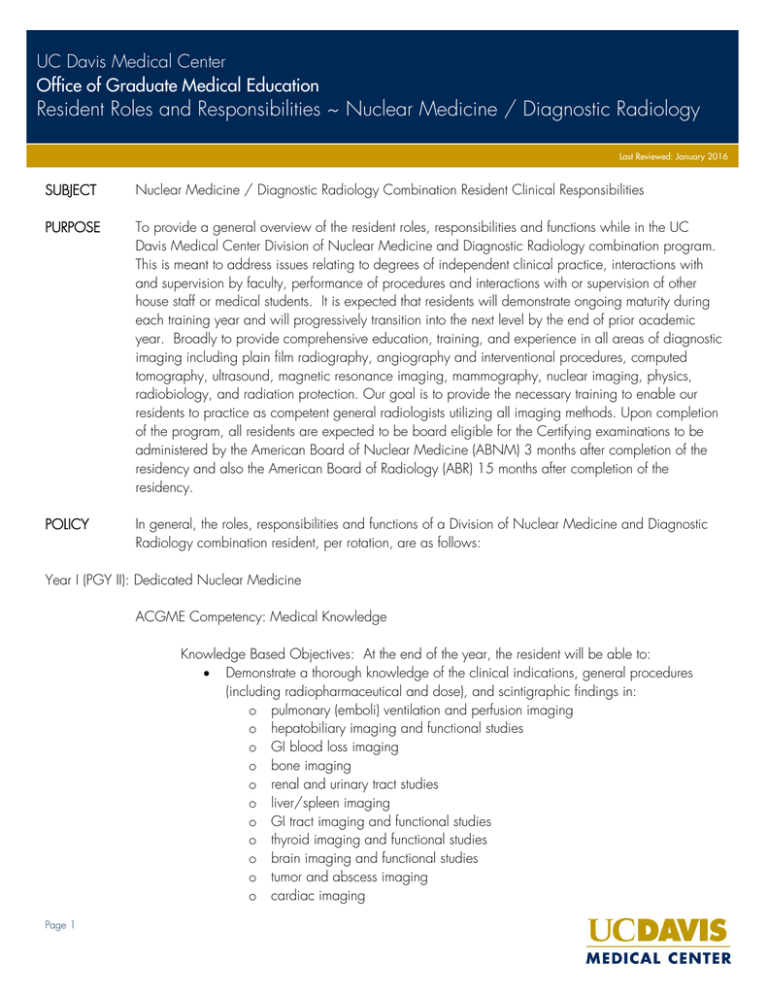
UC Davis Medical Center Office of Graduate Medical Education Resident Roles and Responsibilities ~ Nuclear Medicine / Diagnostic Radiology Last Reviewed: January 2016 SUBJECT Nuclear Medicine / Diagnostic Radiology Combination Resident Clinical Responsibilities PURPOSE To provide a general overview of the resident roles, responsibilities and functions while in the UC Davis Medical Center Division of Nuclear Medicine and Diagnostic Radiology combination program. This is meant to address issues relating to degrees of independent clinical practice, interactions with and supervision by faculty, performance of procedures and interactions with or supervision of other house staff or medical students. It is expected that residents will demonstrate ongoing maturity during each training year and will progressively transition into the next level by the end of prior academic year. Broadly to provide comprehensive education, training, and experience in all areas of diagnostic imaging including plain film radiography, angiography and interventional procedures, computed tomography, ultrasound, magnetic resonance imaging, mammography, nuclear imaging, physics, radiobiology, and radiation protection. Our goal is to provide the necessary training to enable our residents to practice as competent general radiologists utilizing all imaging methods. Upon completion of the program, all residents are expected to be board eligible for the Certifying examinations to be administered by the American Board of Nuclear Medicine (ABNM) 3 months after completion of the residency and also the American Board of Radiology (ABR) 15 months after completion of the residency. POLICY In general, the roles, responsibilities and functions of a Division of Nuclear Medicine and Diagnostic Radiology combination resident, per rotation, are as follows: Year I (PGY II): Dedicated Nuclear Medicine ACGME Competency: Medical Knowledge Knowledge Based Objectives: At the end of the year, the resident will be able to: Demonstrate a thorough knowledge of the clinical indications, general procedures (including radiopharmaceutical and dose), and scintigraphic findings in: o pulmonary (emboli) ventilation and perfusion imaging o hepatobiliary imaging and functional studies o GI blood loss imaging o bone imaging o renal and urinary tract studies o liver/spleen imaging o GI tract imaging and functional studies o thyroid imaging and functional studies o brain imaging and functional studies o tumor and abscess imaging o cardiac imaging Page 1 UC Davis Medical Center Office of Graduate Medical Education Resident Roles and Responsibilities ~ Nuclear Medicine / Diagnostic Radiology Last Reviewed: January 2016 Discuss the basic physical principles of nuclear medicine imaging and instrumentation. Identify the isotopes (including physical and chemical properties) that are used routinely in the compounding or radiopharmaceuticals for nuclear radiology procedures Identify and discuss indications for isotopes used for therapeutic purposes Describe the protocol for using 1-131 for treatment of hyperthyroidism and thyroid malignances, including protocol for hospitalization and monitoring of patients who receive over 30 mCi of activity, and the requirements for safe and effective high dose, outpatient therapy. ACGME Competency: Practice Based Learning and Improvement Technical Skills: At the end of the year, the resident will be able to: Recognize limitations in personal knowledge and skills, being careful to not make decisions beyond the level of personal competence. Review and dictate a broader scope of examinations with the assistance/review of the faculty radiologist. Assist with radioactive therapy treatments, making sure the consent form is completed properly and that the appropriate dose is administered, giving particular attention to radiation safety practices during the procedure. Obtain informed consent for all high risk procedures such as cardiac stress testing. Provide close and adequate supervision to technologists performing examinations as well as to nurses providing sedation or pharmacological administration. Assist with preparation/presentation of interesting cases for monthly resident case conference. All procedures should be directly supervised by your attending faculty. ACGME Competency: Patient Care, Professionalism, Interpersonal and Communication Skills, Medical Knowledge Decision-Making and Value Judgment Skills: At the end of the year, the resident will be able to: Review histories of patients to be imaged each day to determine the relevance of the study to clinical symptoms, to evaluate for contraindications to the study, and to advise technologists about special views or specific parameters of the study that require special attention. Assist technologists in the determination of the radiopharmaceutical dosage when patient conditions do not fit the criteria of the standard dose. Observe at least one of each of the different scans routinely performed, as well as all the infrequently ordered studies. Page 2 UC Davis Medical Center Office of Graduate Medical Education Resident Roles and Responsibilities ~ Nuclear Medicine / Diagnostic Radiology Last Reviewed: January 2016 Make a preliminary review of the images and advise technologists when additional views or repeat views are needed. Recognize limitations in personal skill and knowledge, always making sure dictations and consultations are checked by the attending faculty. Review all scans as they are performed for significant findings that require prompt attention, and make decisions in regard to notification of the referring physician if the attending faculty is not available for consultation. Be involved with the CQI process through occurrence screen forms, incident reports, or discussion with faculty where medical processes can be improved. Year II & III (PGY III & IV): Nuclear Medicine ACGME Competency: Medical Knowledge, Interpersonal and Communication SkiIls Knowledge Based Objectives: At the end of the year, resident will be able to: Identify normal and abnormal findings on all imaging and functional studies. Discuss all aspects of nuclear studies, including indications, pathologies, protocols, correlative studies, radiopharmaceuticals used for each study, and various parameters that might interfere with the results of the procedure. Identify and discuss PET-CT imaging and indications. Be able to do preliminary review of PET-CT scans. Technical Skills: At the end of the year, resident will be able to: Review and dictate with the faculty radiologist all scans performed. Review cases. All procedures should be directly supervised by your attending faculty. Demonstrate increasing technical and procedural abilities such as bladder catherization and lymphoscintigraphy. These procedures should be directly supervised by attending faculty. ACGME Competency: Medical Knowledge, Practice Based Learning and Improvement, Interpersonal and Communication Skills, Professionalism Decision-Making and Value Judgment Skills: At the end of the year, the resident will be able to: Make preliminary decisions on all matters of Nuclear Medicine examination, interpretation and consultation, recognizing need for and obtaining assistance in situations that require the expertise of the attending faculty. Comment on anatomical findings, scanning technique, and reasons for doing the Page 3 UC Davis Medical Center Office of Graduate Medical Education Resident Roles and Responsibilities ~ Nuclear Medicine / Diagnostic Radiology Last Reviewed: January 2016 study to RDI-461 Diagnostic Radiology Medical Students and RNU-463 Nuclear Medicine Medical Students in such a way that the students will be able to develop an appreciation for the value of nuclear radiology procedures in patient management. Year IV & V (PGY V & VI): Nuclear Medicine ACGME Competency: Medical Knowledge, Interpersonal and Communication Skills Knowledge Based Objectives: At the end of the year, resident will be able to: Demonstrate a thorough knowledge of the clinical indications, general procedures and findings in: o Myocardial perfusion studies (rest and stress) o myocardial infarct imaging o multi-gated acquisition imaging and function studies Demonstrate knowledge of the clinical indications, general procedures and findings in PETCT imagines for oncology, neurology and cardiology. Describe the radiopharmaceuticals used in cardiac nuclear studies, including the methods of red cell labeling, patient dosages and physical properties of the isotopes. Discuss patient conditions and patient monitoring requirements, particularly in relation to exercise and drug stress studies. Process computer data obtained in each of the different cardiac studies. Discuss the range of invasive and noninvasive tests, test characteristics and the prognostic value of tests used to evaluate cardiac disease. Discuss the following information regarding all radiopharmaceuticals used in nuclear radiology studies: o production of isotopes o physical properties of isotopes o general elution and quality control o compounding of radiopharmaceuticals o radiochemical quality control o bio-distribution and mechanisms of localization Calculate patient doses, using information related to decay factors, volume concentration, and patient parameters. Describe the procedures and rationale for instrument quality control in nuclear medicine. Discuss rules and regulations that apply to the practice of nuclear radiology as outlined in 10CFR20 and other appropriate sources. Describe the types of records that must be maintained in order to comply with federal/state guidelines for radiation safety and radioisotope receipt/us/disposal. Page 4 UC Davis Medical Center Office of Graduate Medical Education Resident Roles and Responsibilities ~ Nuclear Medicine / Diagnostic Radiology Last Reviewed: January 2016 Demonstrate an in-depth understanding of the physics of nuclear radiology. Technical Skills: At the end of the year, resident will be able to: Review and dictate with the attending faculty all scans performed. Review cases. Understand how to compound radiopharmaceuticals from kits and do appropriate quality control procedures. Understand how to elute a generator and do appropriate quality control procedures. Understand how to calculate and draw up patient doses. Understand appropriate use of a survey meter to monitor radioactivity spills or other sources. Perform a wipe test. Perform quality control procedures on cameras, well/uptake probes, and dose calibrators. Handle radioactive sources according to the established guidelines. All procedures should be directly supervised by your attending faculty. ACGME Competency: Medical Knowledge, Practice Based Learning and Improvement, Interpersonal and Communication Skills, Professionalism Decision-Making and Value Judgment Skills: At the end of the rotation, the resident will be able to: Select tests for evaluation of cardiac disease on the basis of patient condition and clinical symptoms. Correlate the results from various tests with interpretation of nuclear cardiology exams. Carry out the practice of nuclear radiology with due regard to quality control, quality assurance, and radiation safety for the patient and personnel. Year II (PGY III): Diagnostic Radiology Page 5 Become familiar with the broad spectrum of patient examinations and/or procedures as assigned by attending or senior resident, with an emphasis on quality of patient evaluation and patient care. Participate in in-depth discussion of all cases with the attending prior to initiation or dictation of all cases, except the most basic diagnostic studies or therapeutic interventions. All procedures must be done under direct supervision and approval of attending. At the conclusion of 6 months of residency training in core rotations, residents should be capable of working in the capacity of the ER swing shift and weekend back-up radiologist. They provide consultation to emergency room and hospital physicians in the domains of immediate plain film, computed tomography, and ultrasound consultation. They should also have sufficient experience in angiography and interventional procedures to provide competent back-up to the interventional radiologist on call. UC Davis Medical Center Office of Graduate Medical Education Resident Roles and Responsibilities ~ Nuclear Medicine / Diagnostic Radiology Last Reviewed: January 2016 Year III (PGY IV): Diagnostic Radiology Become familiar with patient histories and associated diagnostic radiology examinations and procedures in order to serve as the attendings’ principal resource for day-to-day patient data. Supervise and teach medical students. Gain additional experience within the full spectrum of diagnostic and interventional radiology procedures, with the expectation of increased proficiency. All decisions regarding invasive radiology procedures and specialized diagnostic procedures should be discussed in depth with the attending. All procedures must be conducted under complete supervision of the attending. Upon completion of the second year of training, residents should show increased proficiency in interpretation of plain films, computed tomography, ultrasound, magnetic resonance imaging, and nuclear medicine studies. Year IV (PGY V): Diagnostic Radiology Should develop increased proficiency with full-range invasive and diagnostic procedures. Must discuss all cases with attending prior to performance of interventional procedures and complex diagnostic studies. May assist in interventional procedures or more complex diagnostic studies by senior level house staff. Supervision by the attending is required. They should be able to fulfill night call responsibilities. Upon completion of the third year of training, residents should demonstrate advanced skills in interpretation of routine and complicated imaging studies in all areas of radiology. Residents will be expected to qualify for and pass the Core examination of the American Board of Radiology approximately 36 months into their residency. Year V (PGY VI): Diagnostic Radiology Page 6 Supervises junior residents and has increased teaching responsibility. The responsibility in consultation with other house staff and/or attendings is increased. During the fourth year of training, residents who have passed the ABR radiology core examination and performed well on all rotations will have the option to focus on two or more disciplines within radiology. These “selective” rotations will last up to three months (though usually one or two months) each and are offered in a variety of disciplines within the department. Research selectives of one month’s duration are available provided the resident’s clinical performance is outstanding, in-service scores exceed 50 percentile nationwide, and their research is approved by the residency research committee. If outside funding is acquired, additional time may be devoted to research provided the aforementioned criteria are met. Upon completion of the 4th year of training the residents will be expected to be board eligible for UC Davis Medical Center Office of Graduate Medical Education Resident Roles and Responsibilities ~ Nuclear Medicine / Diagnostic Radiology Last Reviewed: January 2016 the ABR Certifying examination, which will be administered 15 months after completion of their residency. Page 7
